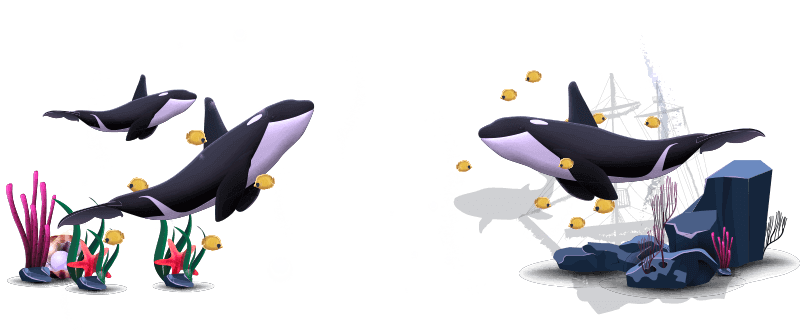Winning Now:


R62,430.00
Maxwell M. on Punky HalloWIN

R22,570.00
Mogomotsi M. on Sweet 16 Blast! XMAS Edition

R18,720.00
David B. on Sweet 16

R17,212.50
Lukoto Z. on Sweet 16

R17,205.69
Mindhunter I. on Mighty Drums

R15,520.34
Andrea L. on Coyote Cash

R15,100.00
Ayanda M. on Hot Pots Master

R13,328.00
Roelien R. on Plentiful Treasure

R13,166.25
Elizabeth M. on Fortunate Zeus

R12,780.00
Janet J. on Horseman's Prize


Whale of a Celebration
This February, dive into World Whale Day and make a splash honouring the ocean's majestic giants!
The sheer size of many whales makes these sea-dwelling mammals simply awe-inspiring. They are also extremely intelligent and use a wide variety of sounds to communicate with each other.
Whales are classed as cetaceans, together with their very close cousins, dolphins and porpoises. In fact, some dolphins are called whales (such as the killer whale or orca, which is actually a very large – the biggest – dolphin) and some dolphins are known as whales (such as the short-finned pilot whale)!
There are two suborders of whales: those with teeth and those with baleen–complex plate structures in the mouth that filter ingested water and catch small sea creatures like krill, plankton and tiny crustaceans. All dolphins and porpoises have teeth, as well as some whales (75 species in all), but about 14 whale species have baleen plates. This obviously has to do with what they feed on. Toothed species feed on larger fish, squid and octopus, while baleen species feed on much smaller organisms. Baleen whales have two blowholes, while their toothed counterparts have only one.
All cetaceans have lungs and therefore need to surface to breathe air, although they can stay submerged for very long periods of time.
Let’s take a look at a few of the whales and dolphins that can be found in South African coastal waters and further into deep water.
Blue Whale
The blue whale is the largest animal on the planet and also the largest animal ever to have lived throughout Earth’s history. Adults can grow to a length of almost 30m and weigh up to 100 tonnes (that’s 100,000 kg!). The throat has over 40 grooves which allows the mouth to expand for feeding and the top jaw has over 300 baleen plates on each side to filter food. The calves are about 7m in length when born and can weigh between 2 and 3 tonnes, consuming up to 400 litres of milk each day from its mother’s single nipple, which in a blue whale, is up to 1,5m long.
Fun fact: Whale milk is the consistency of toothpaste, mainly because it contains up to 50% fat. Not only does the fat provide major nourishment for the growing calf, but also prevents milk from dissolving in the water.
Whale Sounds
Humpback Whale
Humpback whales have distinctively long pectoral fins, up to one third of their total body length. Because of this they are in a unique class known as Megaptera, meaning ‘large wing’. This species can grow up to 18m in length. Females become sexually mature when they’ve grown to 12m and tend to be larger than the males of the same age.
While we have the privilege of seeing these whales off our coastlines for a few months, they are generally migrating from the Arctic, making their way north to calve and mate in tropical waters off Mozambique and Madagascar. During this time they don’t feed, as their diet consists almost exclusively of krill (small crustaceans) found in the polar regions.
Fun facts: Humpback whales can breach spectacularly, launching their entire bodies out of the water. They are also the most vocal of all whales, the males singing haunting and complex songs lasting up to 20 minutes. These ‘songs’ are learnt and passed on to specific groups.
Southern Right Whale
Sadly, the ‘right’ refers to the ‘right’ kind of whale to be hunted to near extinction for their oil, meat and whalebone (baleen) as they were for well over 200 years, only ending in the 1970s, when just 10% of these animals remained. However, with the worldwide moratorium on whale hunting (with the exception of Norway and Japan), Southern Right numbers have recovered, as have those of Humpback whales, while many other species are still listed as vulnerable. Southern Rights tend to move in medium to large groups, making whale-watching an unforgettable experience. One sighting off Plettenberg Bay had about 200 individuals congregating on the same day.
Fun fact: The male right whale has the biggest testicles of any animal on earth – each of the testes weighing up to 500kg and producing about 3,5 litres of sperm.
Sperm Whale
The sperm whale is a toothed whale and is easily identifiable – its shape is the most often used in comics, cartoons and toys. They have a large square head that is almost one third of their body length. The lower jaw has about 20 large cone-shaped teeth that fit into sockets on the upper jaw. The extremely large head houses the spermaceti organ which is filled with up to 2.5 tonnes of oil, thought to play a role in amplifying vocalisations and buoyancy regulation, among other functions. Unfortunately, this oil was prized by whaling companies and sperm whales were aggressively hunted for this precious commodity.
You won’t find sperm whales along the coast as they stick to deeper waters. They are masters of deep diving, and have been recorded descending to 3000m, staying submerged for up to two hours.
Fun fact: Sperm whales are the loudest mammals on the planet. Their vocalizations can ramp up to an astounding 230 decibels! By comparison, the average volume of dance music played in a club is 98 decibels.
Killer Whale (Orca)
As mentioned above, the killer whale is actually a dolphin, but because of its size has more in common with whales. They can grow up to 9m long and weigh up to 80,000 kg. The Orca’s distinctive glossy black and white markings differentiate it from all other cetaceans usually sporting tones of black, grey or brown. Another distinguishing feature are orcas’ large dorsal fins, up to 2m in height. They are definitely at the top of the food chain, hunting in packs and preying on other dolphins, seals, seabirds, sharks and, as mentioned above, even whales.
Orcas are sighted off the coast of southern Africa from time to time and certain groups tend to return to specific locations. In False Bay Cape Town, groups of Orcas are regularly spotted, and a notorious pair, nicknamed Port and Starboard, is a familiar sight. The mysterious disappearance of many great white sharks off the Cape coast has been attributed to them possibly falling prey to killer whales, as they have no other predators.
Fun fact: Orcas’ bright black and white markings are actually a form of camouflage known as disruptive coloration, in which the color pattern of an animal disguises the animal's actual body shape. Also being black on top, an orca is difficult to distinguish if it is below its prey, while it’s white underbelly makes it hard to see it is above.
Protecting our precious sea life
South Africa has a magnificent coastline that stretches over 3,000 km, teeming with life. Schools of porpoises and dolphins abound and during a part of the year, we play host to numerous migratory whales. Like other parts of the world, our oceans are under threat, mainly from overfishing and pollution – both of these affecting life in the sea. Whales have washed up on shores with their stomachs filled with plastic trash – fishing nets, plastic bags and containers and other detritus that humans had failed to prevent from polluting the ocean. Fertilizer runoff from rivers is creating dead zones along coastal waters too. If we want to keep celebrating World Whale Day into the future, we need to do a lot more to keep our oceans and their inhabitants healthy.
We love Whales

MORE NEWS
-
- Details
- Articles |
- December 11, 2025
Project Thunderbolt – Sign Up for a Free Spins No Deposit Bonus Boon!
Hot diggity dog Bolters! Project Thunderbolt is here and it’s a promo series geared for infinity and...
-
- Details
- Articles |
- November 27, 2025
The Deeper Meaning of Oz: Now at the Leading ZAR Casino
Is it ounce, is it FUN or is it k*k going down at the Oswald State Penitentiary? At Thunderbolt – the...
-
- Details
- Articles |
- November 14, 2025
Are Arcade-Style Casino Games More Fun to Play Than Online Slots South Africa?
Crash games, catch games, casual games and instant win variations of pinball machines are...






